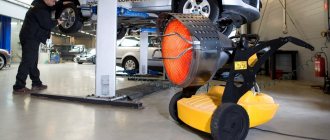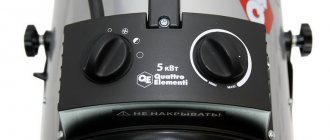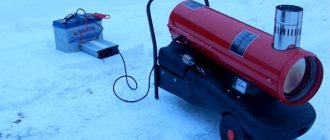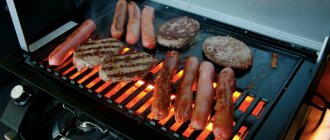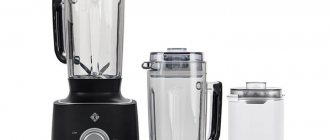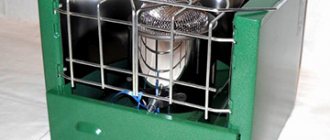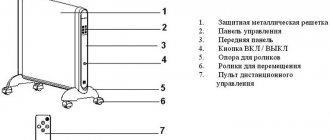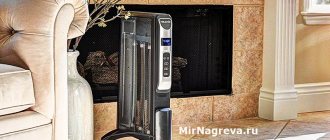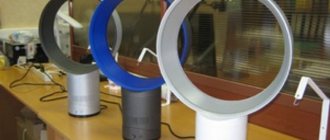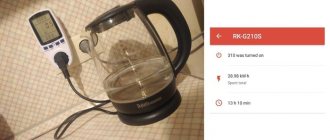SHARE ON SOCIAL NETWORKS
FacebookTwitterOkGoogle+PinterestVk
From this article you can find out what features a diesel heat gun used for quickly heating rooms has: the structure and types of structures, the scope of their application and the specificity of the operating process, average prices for popular models. The text contains an overview of the advantages and disadvantages inherent in these devices, descriptions of common types of breakdowns and ways to eliminate them.
A diesel fuel heat gun is designed to quickly heat indoor and outdoor spaces.
Diesel heat gun: characteristics of heating devices
With the arrival of the cold season, the problem of space heating arises. Moreover, this applies not only to living rooms, but also to industrial, warehouse and retail spaces. If the building does not have a centralized heating system, the lack of heat is compensated with the help of alternative heating devices. As such a replacement, you can buy an indirectly heated diesel heat gun with suitable characteristics.
Mobile heat guns are equipped with wheels and a handle for convenient movement of the device
Design and principle of operation of a diesel heat gun
A heat gun is a universal device for heating rooms. The principle of operation of such structures is quite simple: diesel burns inside the heater, resulting in the formation of heat, which is supplied to the room by a powerful fan.
Diesel is used as fuel. Some models are capable of running on used and filtered oil or kerosene. Thanks to the progressive internal structure, these designs have high power and efficiency, which reaches almost 100%. All diesel heat guns are dependent on electricity. Some low-power modifications can operate on 12 V or 24 V, but most models require 220 V for normal operation.
Electricity is used to start the burner. In addition, it is necessary for transporting heat due to the rotational movements of the fan. The burner not only atomizes fuel, but also promotes air supply. This process results in a mixture that is highly flammable. Thanks to this, the flame is stable.
The principle of operation of an indirect heating heat gun is that the air forced by the fan passes through the combustion chamber and enters the room already heated, and waste diesel fuel products are removed from the room through the chimney
The affordable price of diesel guns and the ability to effectively heat rooms without a central heating system have made these designs so popular. This type of equipment is capable of generating a large amount of heat, due to which the scope of its application has expanded.
Important! Guns powered by diesel fuel cannot be used to heat residential premises.
Scope of application of diesel structures:
- heating of warehouse-type premises;
- backup heating in poorly insulated facilities in cases where frosts uncharacteristic for the area occur;
- heating construction sites where heating has not yet been installed;
- organization of heating in hangars used for storing equipment;
- installation of suspended ceilings;
- heating of greenhouse structures used for growing crops.
In addition, you can buy an indirect heating diesel gun to organize heating in the garage.
Diagram of the design of a diesel heat gun of indirect heating
Why is it profitable to buy a diesel gun: design advantages
Guns that heat rooms by burning diesel fuel have many undeniable advantages. They are compact in size and light weight, while having excellent technical characteristics. These designs are easy to use. The mechanism is started with just one press of a button. The user has the ability to control the temperature in the room.
Many diesel designs have a built-in system for connecting a rheostat. The operating principle of this mechanism is very simple. Before launching the gun, you just need to set the required parameter. When the room temperature reaches this value, the equipment will automatically turn off. If the temperature drops below the specified level, the structure will start on its own.
Diesel guns are economical; fuel consumption depends on the technical parameters of the device. Equipment with a power of 20 kW and a productivity of 550 m³/h will require about 1.5 liters of diesel fuel to heat this volume. Using such a gun, you can achieve quick results. According to the information stated by the manufacturers, diesel devices instantly warm up the room. The gun can raise the air temperature of +10°C in a room with a volume of 120 m³ to a level of +180°C in 15 minutes. Moreover, this speed is not the limit.
Small diesel fuel heat guns are convenient for use in closed, unheated rooms
Diesel devices are safe to use. If the room is well ventilated, inhaling burnt-out air does not cause such unpleasant consequences as headaches and dizziness. High-quality designs are able to work for a long time without additional refueling. The guns are equipped with large-volume tanks, thanks to which they are able to operate continuously throughout the day.
Note! The body of the structure is heated to a temperature of +30-35°C maximum. Therefore, accidental touching the gun will not cause burns.
Disadvantages of using diesel heat guns for garages
The customer reviews left about diesel heat guns for garages not only reflect the advantages of these designs. Sometimes they also contain shortcomings that were identified by users during operation of the device.
Diesel fuel heat guns are often used to heat garages and workshops
High noise levels are often mentioned as a serious hearing irritant. Although the presence of sounds is considered normal for heating equipment. Guns are not classified as silent devices. Some manufacturers offer models with reduced operating noise levels. For example, the Master BLP 15M diesel heat gun produces no more than 20 dB. This figure is considered very low.
Many users find the dependence of devices on the electrical network inconvenient. The gun really needs power for the fan and pump, and there is no way around these requirements. However, most often such structures are used in facilities where there is electrical wiring.
Among the disadvantages, the high price of diesel heat guns is also mentioned. However, it should be noted that the cost of such devices is fully justified by their reliability and comfortable operating system. Many are concerned about the cost of diesel fuel, the purchase of which is more expensive than the purchase of liquefied gas in cylinders. Although the fuel consumption of these devices is low.
Diesel fuel heat guns require an electrical connection for the built-in fan to operate.
How to choose a heat gun based on technical parameters
One of the most important technical parameters of any heat gun is its performance level. In the specifications, manufacturers indicate the number of kilowatts that the gun is capable of producing in intensive operation. You can also calculate the performance level yourself.
On average, a power of 1 kW is enough to heat an area of 10 m², provided that the ceiling height does not exceed 3 m. This figure is conditional, since it depends on the operating conditions of the room that needs heating.
Factors that affect heating efficiency:
- wall thickness;
- availability and quality of insulation;
- condition of the ventilation system;
- heat leakage (frequency of opening gates or doors);
- number of windows and doorways, their size;
- outside air temperature;
- condition of the floors;
- wind force, etc.
Diesel fuel heat guns are available in different capacities, which allows you to choose a device for both a small room and for production facilities and hangars.
The price of a diesel indirect heating heat gun is not an indicator of quality. When choosing a device, it is advisable to pay attention to powerful modifications. The higher this indicator, the better. If there is a lot of heat, you can always reduce the intensity of work. And if there is a lack of heating, you will have to buy another device, which will significantly affect the budget. The efficiency of a diesel heater is also influenced by its installation location.
Helpful advice! In large rooms it is advisable to use several heaters. Arranging appliances diagonally will be more effective than placing them along the wall.
Cold air is always heavier than warm air, so it always accumulates in the lower part of the room. Based on this, it becomes clear that installing the gun on a hill or turning its working edge upward does not increase the heating efficiency. The most optimal position of the equipment is horizontal.
The Ballu BHDN-20 indirect heating heat gun model is capable of heating a room up to 200 m²
The performance of heating and ventilation equipment is another parameter that you should pay attention to. For the Ballu BHDN-20 indirect heating diesel gun, this figure is 500 m³/h. This means that the device is able to effectively heat the specified volume of air within 1 hour.
Not least important are the dimensions and weight of the structures. The mass of heat guns can vary between 3-30 kg. Most of them have a mobile design, so they are easy to use. The smaller the device, the easier it is to move.
Characteristics
To understand which device is better to buy, you need to carefully read its characteristics. The functionality of the equipment is one of the most important selection criteria. The popularity of models is also influenced by cost, power, and equipment.
| Characteristic | Description |
| Air heating type | Direct, indirect. |
| Heating source | Diesel. May be gas or electricity. |
| Dimensions | Specify the width, height and depth of the model. |
| Power | The power of small indirectly heated guns is 20-85 kW. There are industrial high-performance devices in which this figure can reach 220 kW. |
| Ventilation | Measured in m3/h. For example, for Master brand models it varies from 1,550 to 3,300 m3/h. For industrial ones - 4,400-12,500 m3/h. |
| Cannon shape | Rectangular devices have a larger area for inflating heated air. |
| Mobility | A device on wheels is more convenient to use than a stationary one. |
| Power and temperature adjustment | Devices with power control are equipped with a knob that programs the thermostat settings. |
| Heating speed | How long will it take for the gun to heat the room? |
| Fuel consumption | Heat guns for industrial areas have the highest fuel consumption. This is directly related to greater productivity. |
| Room area size | The area of the room that the device can heat is often indicated. |
| Weight | The design of the device and the material of the housing influences. |
| Guarantee | The specifications always indicate the period during which the user can apply for a free replacement of the device if it breaks down. |
| Manufacturer country | The country in which the device was released. |
| Equipment | Listed are the additional accessories that come with the kit. For example, hoses and nozzles. There may be a room thermostat. |
| Price | The devices are inexpensive (up to 25,000 rubles) and heat small rooms. Industrial guns with high power are produced for production areas, which cover an area exceeding a thousand m2. Their cost is many times higher than those with lower performance. |
Features of direct heating diesel heat guns
Direct heating guns are the simplest devices that can serve as heat sources. Such designs have an open combustion chamber. A pump equipped with a nozzle is installed inside, which ensures a torch effect. A fan is located behind these elements. All the heat that is generated during fuel processing is supplied to the room along with the products of its combustion.
Operating principle of a direct heating diesel gun
Operating principle of a direct heating diesel gun:
- Diesel fuel from the tank is fed into the heating filter.
- The compressor transports fuel to the injector.
- Diesel fuel is ignited by a glow plug.
- A fan installed behind the burner draws cool air from the room into the combustion chamber, where it is heated.
- The protective mesh located in the front part of the device traps the flame, preventing it from penetrating beyond the combustion chamber body.
- After heating, the air is supplied back into the room.
Related article:
Thermal curtain for the front door: the key to creating a comfortable microclimate
Design and principle of operation. Types of thermal curtains. Installation and repair of the device. Well-known manufacturers.
The operating principle of a direct heating gun is quite simple. It is efficient and clear. However, such guns have one significant drawback. All combustion products enter the room, so it is not recommended to use the devices in living rooms. Direct heating guns are suitable for open areas and spaces with a good ventilation system.
Average prices of diesel guns for space heating (direct heating designs):
| Brand | Model | Power level, kW | price, rub. |
| Resanta | TDP-20000 | 20 | 11890 |
| TDP-30000 | 30 | 13090 | |
| Ballu | BHDP-10 | 10 | 13590 |
| BHDP-20 | 20 | 14430 | |
| BHDP-30 | 30 | 17759 | |
| Master | B 35 CEL DIY | 10 | 21590 |
| B 35 CED | 10 | 21790 | |
| B 70 CED | 20 | 31260 |
Note! Using fuel with impurities will lead to contamination of the injectors and other unpleasant consequences. Therefore, it is very important to use high-quality raw materials to avoid expensive repairs and the purchase of spare parts for a diesel gun.
Heat guns can be used to heat greenhouses year-round
Consumer opinion about diesel heat guns: reviews of direct heating designs
Users of heating equipment often share their own opinions on forums. Some reviews can be found below:
“I have long heard about the advantages of Master diesel heat guns, so when the need arose to purchase a heater, I did not think twice and relied on this manufacturer. The gun works great and is completely worth the money spent on its purchase. With its help, I not only heat the garage, but also take this device with me to the dacha for the workshop.
Of course, it’s a pity that you can’t work in a room where the gun is on, but I don’t really need that. It takes no more than 20 minutes to warm up the room. Otherwise, I am completely satisfied with my purchase."
Sergey Kostyuk, Ekaterinburg
“I bought myself a BALLU BHDP-20 diesel heat gun. A wonderful unit. For a month of operation, there were no failures in the automation, as was the case with my previous gun. I like that the design allows you to adjust the pressure on the compressor that supplies the diesel. There is only one drawback - with a full tank the device is slightly heavy.”
Igor Samoilov, Moscow
Most heat gun models have high safety standards, which prevents injury from accidentally touching the device
“To heat the garage, a neighbor advised us to buy a heat gun. I spent a long time looking through manufacturers and models. In the end, I settled on the Master B 35 CED diesel gun. Excellent device, very simple. It is economical and completely easy to maintain. I've been using it for more than a year now. One refill is enough to keep the gun working all day. A 5x8 m garage warms up in 15 minutes.”
Georgy Miroshnichenko, St. Petersburg
Design features
The operating principle of this class of units is no different from other heat guns: the combustion chamber housing is cooled by air pumped by a fan. The warm air is then directed to heat the room. Gas heat guns differ structurally from their electric counterparts only in the presence of a burner instead of a heating element (HEN). The gas ignites automatically using a piezoelectric element.
This device can be used both for residential premises and for heating production facilities. For example, a high-performance gas heat gun with a power of 10 kW can heat a room in a new house with an area of 150-300 square meters. m. or a greenhouse up to 70 m2. If the gun has a power 10 times greater, then it is capable of efficiently heating a building with an area of about 3.3 thousand square meters. m or greenhouse - 740 m2.
One cylinder of propane gas is enough for approximately 60 hours of operation without stopping, and it must be taken into account that the fan heater turns off automatically when the set temperature in the room is reached, and then turns on if the temperature drops. For autonomous operation, a gas cylinder with liquefied natural gas is connected to the product, which can be easily replaced as used.
Device of direct heating gas guns
There is a fan in a cylindrical housing, followed by a burner behind it (closer to the “exit”). Air is sucked in from the back of the housing, passes through the fan, blowing the burner. Gas is supplied to the burner, which is ignited by ignition. The gas is mixed with the air flow, which promotes more complete combustion.
Direct heating gas gun device
A good quality gas heat gun is designed in such a way that even at the highest power the flame does not extend beyond the body. There should be only a stream of hot air at the outlet. As you can see, the device is not too complicated and its operating principle is simple. The design is complemented by filters - air and fuel, various sensors and safety devices.
Indirectly heated gas guns
The main disadvantage of the above design is that combustion products remain in the room. It is clear that this has a negative impact on well-being and, as a result, on overall health. But this option has a very high efficiency - 95-98%. Therefore, these are the models that are chosen in production or for temporary use.
There are gas guns without exhaust. More precisely, the exhaust is removed from the room through a pipe. The design of such models is more complex. The combustion chamber is the same cylinder, only it is sealed in relation to the room. In the upper part it has an outlet pipe through which combustion products are removed. Heating occurs due to the fact that the air driven by the fan blows through the combustion chamber, taking away heat from the walls. That’s why these models are called indirect heating heat guns. First, the heat exchanger heats up, and the air from it heats up.
Indirect heating gas gun device
To ensure more complete heat extraction, gas from the combustion chamber moves through a labyrinth. This increases the efficiency, but this figure still does not rise above 80-85%. But such installations do not harm health, they can be used on a long-term basis.
At the moment, the range of indirectly heated gas guns is very scarce, and prices are high. First of all, these devices are aimed at large production and warehouse premises.
Indirect heating gas gun Ballu JUMBO 200 T LPG. Maximum power - 220.9 kW, price - 512,000 rubles
Features of diesel indirect heating heat guns for the garage, prices and reviews
This type of gun functions in much the same way as direct fired designs. The only difference is that the combustion products that are formed during the process of fuel exhaustion are removed outside the room. A chimney is used for this. Thanks to this, indirect heating guns can be used in almost any room with a sufficient level of ventilation.
Powerful heat guns have impressive dimensions and are used to heat large areas
A nozzle is installed in the design of the closed combustion chamber. In addition, the gun has a system designed to remove combustion products. The air pumped by the fan does not come into contact with the torch. Its heating is provided by blowing into the combustion chamber.
Average prices of indirectly heated diesel heat guns:
| Brand | Model | Power level, kW | price, rub. |
| Profteplo | DK-21N | 21 | 29930 |
| DK-21R | 21 | 32250 | |
| DK-21N-R | 21 | 44920 | |
| Kroll | MAK 15 | 15 | 34350 |
| MAK 25 | 26 | 41180 | |
| MAK 40 | 38,5 | 44500 | |
| Aurora | TK-55 ID | 17,5 | 37400 |
| TK-80K ID | 25 | 43400 | |
| TK-240K ID | 70 | 70200 |
Helpful advice! The thermal power of a device for heating a room can be determined using this formula: Q (in kcal/h) = K × V × ΔT, where Q is the required level of thermal power, K is a coefficient reflecting the degree of heat dissipation, V is the total volume of the room, and ΔT is the difference between the outside temperature and the one required to create a comfortable indoor microclimate.
Heat guns are often used to heat tents during the cold season
Consumer opinion about diesel heat guns: reviews of indirect heating designs
Reviews from forums about indirect heating guns:
“I use the KROLL MAK15 gun and am completely satisfied with this unit. No more than 1.5 liters of diesel fuel is consumed per hour in maximum operating mode. It was the efficiency that attracted me to this model. The tank is designed for 30 liters. In the winter, I only use winter diesel, otherwise the fuel just settles. There are no problems with starting."
Evgeny Doroshenko, St. Petersburg
“After an accident on the heating main, which provided heating in the garage, we had to buy a Master BV77E diesel heat gun. The unit is, of course, large. The length of the body exceeds 1 m, and the weight of the structure with an empty tank is neither more nor less than 55 kg. Fortunately, the manufacturer provided the possibility of convenient transportation, which I could not help but appreciate. The device comes with a trolley on wheels. The construction is quite durable. After 3 months, no breakdowns, backlashes or extraneous sounds. The only thing I don't like is the need to constantly check the fuel. Yes, and filters need to be changed from time to time. Otherwise the device is great.”
Konstantin Nalivaiko, St. Petersburg
Indirect heating guns require an air duct through which warm heated air enters the room
Advantages and disadvantages
Diesel heat guns have a number of advantages in their arsenal:
- good performance in a compact size;
- ease of use (one button control);
- efficiency (low fuel consumption - 0.86 l per 10 kW);
- long time of continuous operation (up to 14 hours).
But any product also has its negative sides. The greatest dissatisfaction among users of diesel heat guns is the excessive noise created by the device during operation. Knowing about this complaint from consumers, manufacturers offer models with reduced noise levels.
The relatively high cost of the device is also mentioned among the disadvantages, but here it is important to really evaluate its effectiveness, and in some situations its irreplaceability. In general, diesel heat generators have a good price-quality ratio. The fuel itself will require material investments, but its consumption is small, so the costs for this expense item will be moderate.
Features of repair of diesel guns for space heating
Repair maintenance for a diesel fuel-powered installation can cost a significant amount. Just one diagnostic procedure costs about 1000 rubles. For this reason, many owners of garages and warehouses resort to self-repair of structures.
How to repair a diesel heat gun yourself
If warm air does not move, the fan motor may be faulty. Repair involves cleaning the terminals, checking the winding on the motor (an analog tester is suitable for this), as well as insulation. Sometimes the damage is so serious that superficial adjustments are not enough. In such cases, there is only one thing left - replacing the engine.
An important design detail is the nozzles. The quality of operation of these elements depends on the full functioning of the entire heating system. These parts rarely break, and new elements to replace failed ones can be bought at any store.
Modern diesel, gas and electric heat guns are equipped with a convenient control panel that allows you to adjust the air heating temperature
Much more often, the need to repair a diesel gun arises due to a clogged filter. To eliminate this breakdown, simply open the housing of the structure, unscrew the plug and remove the contaminated element. After washing with clean kerosene, the filter is ready for further use. Before installing this part in place, it is advisable to blow it out with a jet of compressed air.
How to choose a gas gun
If the garage does not have any communications other than electrical ones, it can be heated using an autonomous heating system. Many people use a device such as a heat gun. It has the ability to quickly heat a room.
In order for the air temperature to remain at the same level after heating, it is necessary to first take care of thoroughly insulating the building.
Insulation also helps protect the metal garage from corrosion. Warming up the garage from the inside almost always leads to the formation of condensation, which causes oxidation and destruction of metal structural elements. That is why the first rule of heating is the mandatory installation of a high-quality ventilation system.
How to choose a heat gun:
- It is necessary to take into account the volume of the room, temperature conditions at different times of the year, and the insulation coefficient, which depends on the thermal conductivity of the materials from which the garage is made.
- The unit must be reliable and of high quality, especially in cases where long-term heating is required.
The operation of a heat gun is based on the principle on which a fan heater operates. They are divided into three types, depending on what energy resource is used for their operation. The device can be electric, diesel or gas.
Main design features
If a heat gun is required for heating, the choice must begin by taking into account the configuration of the unit housing. On the heating equipment market, manufacturers offer models of two forms:
rectangular;
tubular
The tubular variety has an oblong steel body, similar to a cylinder. A heating element is fixed deep in the body, which provides almost instantaneous access to the nominal temperature. And the tubular external unit allows for a directed flow of hot air.
The object warms up extremely quickly; a heat gun of this type is suitable for drying rooms. However, dust and dirt, when sticking to the coil, can become a prerequisite for the appearance of foreign odors and excessive oxygen consumption. Therefore, for residential buildings this kind of device will be irrelevant.
Each type of heat gun has its own characteristics
The rectangular device contains a heating element as a heating source, and it, in turn, is much safer than a heating coil. Heating is not as fast as it is in the tubular model, but at the same time it is more convenient and pleasant than from modifications with a tubular body. The device can be used in residential and office premises. The block is not so large and does not require much space.
It is worth paying attention to the structural components of the heat gun. If you buy it for stationary use, you should make sure that it has a stable stand - legs or foot
